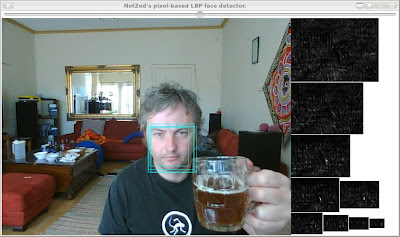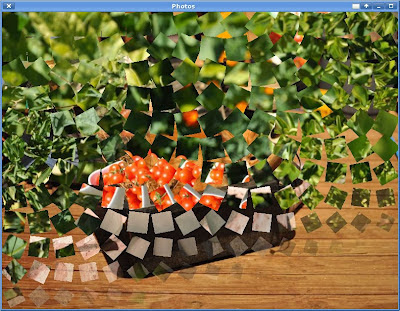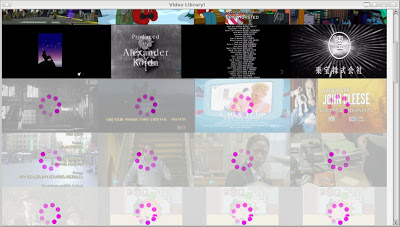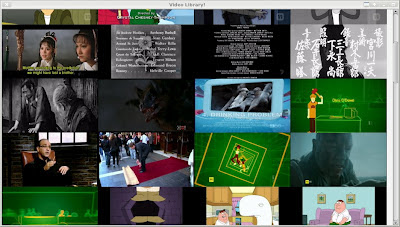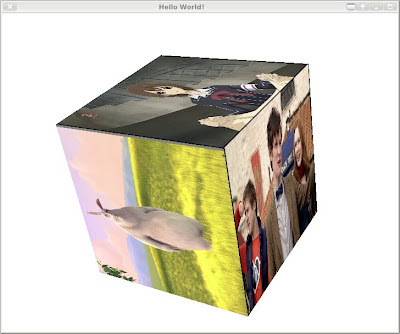About Me
Michael Zucchi
B.E. (Comp. Sys. Eng.)
also known as Zed
to his mates & enemies!
< notzed at gmail >
< fosstodon.org/@notzed >

The Thick Object Detector
This was one of the first JavaFX things I played with - I was just hoooking up a web camera, but since that isn't too much on it's own I added a bit of code I'd been playing with at the time. An object detector.
It only works on systems with a Linux kernel.
Using pretty simple single-threaded Java code on the 640x480 input including generating the heat-maps, totals about 55ms per frame on my workstation. But the algorithm is parallelisable[sic] right down to the SIMD level, and because it's so simple it isn't even hard to do.
I'm not going to go into the training algorithm I'm using at the moment, but suffice to say it's very simple and very fast. Even though it's so brain-dead thick it still shows some promise - but still needs more work.
Source is over in MediaZ under fxperiments/FXDetectLBPP.
Beer time ...
JavaFX Slideshow 2
I had another poke at the slideshow idea, I wanted to play with tiled transitions, how to do them and to see how well they performed.
Works pretty well with the GPU driver, but a little chunky as an applet or with the cpu driver - but here's the Applet & Web Start launcher of a canned demo. I just included 4 shots of mine in the jar to simplify loading them for a demo. It looks much better if it can keep up with the frame-rate requirements.
It's only doing random effects so sometimes they're a bit bland (and i'm not sure if the webstart version implements all effects), but some quite nice transitions come up sometimes. The only 'trick' is breaking the image up into multiple image views - i.e. just texture mapping squares of image separately. Each ImageView is just then animated separately after that. I had to create my own Interpolator as the default ease-in one is a bit flaccid for my liking - although creating a spline in your head is a bit hit and miss ...
Source is in MediaZ under fxperiments/FXSlideZ.
Update: For various reasons I had a lot of time and the inclination to poke today, so i hacked in a few more things into the code (this stuff isn't in the applet).
First I added a 'start from centre' translation transition for the block animator which leads to some particularly pleasant transitions. Then I played with smaller rectangles - it changes the feel of the animations more than you would think, quite pretty, but it quickly starts to bog down the transition setup code as the tiles get smaller. About 20x20 is a reasonable compromise although I left it at 40x40. At 10x10 it takes a couple of seconds to build the transition tables.
Finally I worked out 'mask' based transitions and hacked them in as a random option. I tried a couple of variations, rendering to a canvas, just animating a shape (text), and changing geometry (a filled arc). That should cover about every possibility one might want. It's mostly just down to getting the blend modes and layout right and making sure the end of the animation covers the whole window.
Smooth video list
Another morning hack: seeing if i can use JavaFX to display a smoothly operating user interface whilst crap is going on in the background.
I was thinking of something like the PlayTV library interface and so on, where one should be able to smoothly scroll even if the video is loading or something is busy. It sort of works on the PS3 but I/O really gets in the way there.
So here's a very rough prototype of the same idea - except here every video visible is also playing at the proper speed (sans audio again) as well.
Again: without seeing it in motion it doesn't really do it justice. The shot above is after scrolling a bit, and it shows the 'busy spinner' until the video starts playing, and then the video slowly fades in to cover it.
And this is a bit later. Everything is smooth and responsive and keeps up fine (on a beastly workstation of a couple years vintage). It runs ok even with the CPU driver, but the GPU one is much better.
I used a FlowPane for the layout, so it dynamically readjusts should one resize the window. I then manually calculate which parts of the FlowPane are currently visible, and use that to initiate the transition to loading the video. The video just restarts if one moves away and comes back, although if you knew the seek was going to work that would be possible too (libavformat cannot seek on some files, and the fallback is unpleasant).
I used jjmpeg for the decoding again, although this time I hit a problem with the way i was sending frames to the display - writePixels has to be on the GUI thread too. Got around it with a frame copy ... they're only small frames. It also has some pretty major memory leak somewhere which shows up when scrolling about ... might need to poke around jjmpeg some to track that or it could be errors in the listener code - i'm not really familiar with JavaFX callback rules yet.
With these particular videos (transcoded tv stuff in mp4), it still runs pretty smooth even if I maximise the window ... that's 8x7 ... 56 concurrent decodes and display (actually 64 when it's between rows). Less than 500% cpu on a 6-core HT machine (ok, so it's basically maxed out, but it still copes). (ho hum: if only the hardware video decoding wasn't locked away from being accessed by the customers who bought it, as it is, who gives a shit about that).
MediaPlayer
I also tried MediaPlayer but it wasn't so hot. I'm not sure if you can get it to scale the image data host-side, but without it it's pretty bad. Whilst it plays (oh and with sound, which isn't so good! I muted that) it's a lot slower (only some frames shown) and the whole GUI chunks around all over the place when you scroll: i.e. exactly not what I was trying to achieve in the first place. The scaling quality is poor too.
I'm assuming 'MediaPlayer' must be created from the GUI thread here, it seems to be doing a good bit of synchronous stuff when it is.
I also seem to have some memory leaks here too, but whatever the reason they add up much much faster than with the jjmpeg stuff.
Source
I checked it into MediaZ/fxperiments/VideoLibrary, and it needs a checkout of jjmpeg to work (Netbeans).
Update: I wasn't going to post it but I also created a really shitty video of it in action: didn't realise my camera only does 720P@24, and the aliasing of the LCD pixels is very poor. I also downed the bitrate to make it smaller. But you can get an idea of how it runs anyway.
Pure woof!
So i finally got my order from focalprice delivered ... it got stuck in their system for a month (i think it got confused as to whether i had to reply to a query) and took a while to come through the mail. The padded bag was pretty knocked about and even torn under some tape, but somehow the contents arrived without being busted even inside some crushed boxes.
Got a new battery for my X61 thinkpad ... the previous one died about a year ago. It didn't exactly slide in cleanly and is a bit bendy, but I got it in eventually, I guess time will tell how well it works. At nearly 1/10th the price of the last one I got, I don't have a high bar for it to be considered worthwhile. So long as it doesn't burn the house down ...
I also grabbed an Ainol Novo 7 Elf ii 7" tablet - so I finally have a tablet of my own rather than a work thing. Seems quite well built, and the performance is pretty decent. The main downside so far is the video player isn't properly playing everything I have here. Video plays ok (actually very nicely, although not scaled in the default player) but for many files there's no sound. But other players play the sound (even jjplayer almost works on this thing) so it's either something to do with the hardware sound codec or some other strange bug. I even tried cyanogenmod but to no avail (although at least the firmware install process is simple). The Mele plays a lot more formats out of the box with their custom player. It's not like I need another screen to watch videos on (right now i have 5 in visible reach), but since it's there ... The screen needs to be fairly straight on too, particularly vertically in landscape (which makes portrait mode a little tricky as unless you're in the right spot one eye gets a darker view than the other), so I probably should've gone the few extra $ for the Aurora - i knew as soon as i ordered it that it wasn't worth the few $$ difference w/ the smaller flash too. But for the price it's really not that bad - i've just been spoilt so far with high-end devices. Should be handy for hacking on anyway. Oh and firefox is fairly decent now on android so I can use it for dunny-surfing ...
And lastly just for fun I got some 'ThinkBox' MD-18 mini speaker/mp3 player things. Mostly to give as presents. My sister had a 'music angel' which was kinda nifty and after poking around on-line I got the ThinkBox equivalent which also has an LCD display because I though the 3 button/no screen interface made it a bit hard to use ... It's basically a music player/fm radio/powered speaker with a built-in battery - it puts out enough volume to be usable as a computer speaker. It has sd-card slot, a usb slot for charging and line-in, and a usb-host for usb flash drives. Fairly solidly built (at least on the outside) and the firmware - whilst not wonderful - is passable.
It's almost worth it for the blurb on the back of the box, it's pure woof!
- New mini aluminuw vibration film loud speaker, which has caear alt and pure woof. The unique design makes tone performance perfect.
- Metallic,shell shows noble and fashionable,out of ordinary, with many colours,several solution;for your option.
- Several power supply manners including bactery,computer USB,adaptor DC-5V allow you to enjoy the charm of digital products at any time.
- Mini audio box with new concept integral stereo portable mobie music, connecting your MP3, CD, DVD, iPod, GPS, PSP, mobile phone, notebook computer and Micro SD/TF.
Well that blew my morning away ... I suppose i had better do some work now.
Simple infinite canvas
Just for a laff I coded up an 'infinite canvas' thing in JavaFX.
In the back of my mind I have the idea of making a JavaFX version of ImageZ ... but I'm also not sure I could be bothered going the whole hog. Although i could dump much of the code (although no more float support), there's still a lot of crap to deal with implementing basic features like undo.
This runs faster with the CPU renderer than with the GPU one. Drawing is about the same, but if you end up with a scene with many tiles created, the CPU pans faster ... which isn't what you'd expect. It can easily gobble up the whole heap if you create some gigantic image by zooming out a long way.
I didn't originally intend to, but since it was there I also copied the applet + webstarter to the site as well. The main reason is i've not yet had any such JavaFX applets work - but since this one did, there it is. One might need the very latest JRE for it to work (1.7.0-7). Update: I couldn't get it to work on my laptop, but that might be an old firefox - it ran fine from the jar.
I also started a new sub-project `fxperimentz' in MediaZ to chuck these experiments.
Update: Oh, i forgot to check the source in, it's there now.
The #1 Java feature I most desire ...
... is native complex numbers.
And I mean proper high-performance primitive complex numbers using standard operators and syntax. Not that horridly slow immutable object version in the apache maths libraries and being forced to use extremely messy function calls and manually having to de-infix every equation.
I had to write my own class of mutable complex numbers to get any sort of performance (and it is much much faster) - but it's even (a slight bit) uglier than the apache stuff to use. And on writing it yourself: thank you thank you cephes.
Right now coding complex arithmetic in C is far and away easier but the JNI required makes it a bit too painful for prototyping.
The only saving grace for me personally is that OpenCL C doesn't have them and if the algorithms make it that far I need to manually code the arithmetic up anyway.
Java and legacy operating systems, graphics drivers, &c.
So I had to jump into the same operating system the client uses to verify some code changes still worked - really just a formality as I have jjmpeg working fine there and I was only changing some Java code.
Pretty weird results though. First I had some unpleasant flashing when the code was painting a bitmap - I thought it might've been from the latest jre update together with my habit of poking BufferedImage array's directly, but I checked and this code doesn't do any of that. All it does is replace the bitmap pointer and request and invalidate the component. Annoying but no show stopper.
But then the whole system crashed, ... graphics driver? Who knows. Probably. The AMD drivers are known to be ... problematic.
I rebooted, updated the AMD driver and rebooted again and in the short period of verification which followed I didn't see it happen again.
Except then I noticed something else - part of the application runs slower. Based on user input I do a bunch of deconvolutions on frequency-domain data, convert it back to spatial and merge the results to an image. It runs in another thread and on GNU/Linux it pretty much keeps up with as fast as the sliders move. Under the other system I noticed it was a bit laggy - nothing great but noticeable. The result of all this goes to a view which one can zoom using the scroll-wheel. Doesn't make any difference to the performance on GNU/Linux - it's just scaled during the paint() call, but it drops to a crawl on that other system if one zooms in a few times ... like down to 2-3 fps or something shocking.
As I was there I also tried the slideshow thing I wrote for JavaFX too. Apart from not traversing directories as I thought I was (bug), it was definitely slower there as well. Noticeable lags just as it started to transition in the next image. Possibly from GC, or from the blur effect.
I previously noticed other weirdness when I was playing with Glassfish based application a few months ago (in hindsight I should've just used the embedded webserver in SE, but i digress). I had few troubles getting it going on my system - just installed into ${HOME} and pointed netbeans at it - and just let it manage it. But all sorts of issues on the other system. In the end I had to use the command line tools to get anything to work (it was being used for development and running it, so having netbeans function would have been beneficial), and a few other bits of system pokery jiggery I shouldn't have needed.
Maybe it's just a Java thing, but shit just doesn't seem to work too well on that legacy system ... and that's before you count the unusual disk activity and long pauses opening applications.
JavaFX Media, or not, and a Video Cube.
I got a bit stuck at work today (yesterday) so I took the arvo off. It was the warmest day post-winter (25 degrees, but windy) which was a good excuse, but I also had a lazy look at the JavaFX media stuff.
Actually as per the updates on the previous post I also discovered how to enable GL acceleration on AMD hardware, and it gave the appropriate speed-up - given the previous iteration was using Java2D, it shows just how decent Java2D is (Java2D is rather nice).
But as to the media player - nice api - pretty weird results. Despite using ffmpeg, it only supports a limited number of formats and one of the transcoded tv shows I put through it played back oddly. Sound was ok, cpu usage was very low, but it skipped most frames, and not in a particularly regular way either - making it uncomfortable to watch. Who knows, maybe it's a non-standard encoding or just a bug with the current implementation.
So I guess I will port over jjmpeg at some point - it's not like it should be much work. ... although sound looks as painful as ever ...
Video Cube
Ok I had another play with JavaFX this evening. It might not be as technically impressive as 9 Fingers, but this one is actually decoding the 6 videos concurrently (2xPAL MPEG TS, 4xlesser MP4), and runs smooth with only about 1.5 cpu cores busy (I7 6x core blah blah).
It looks a lot better in motion (actually I locked this orientation to get a screen capture - otherwise it updated too fast and mucked it up) ... seems to run 'full frame rate', with no tearing I can see. I'm not buffering any frames ahead of time or doing anything complex - but it seems to be keeping up with all the video decodes as well. I get the occasional jump if the system is busy - mostly netbeans displaying the debug logs.
Rather than using MediaPlayer I'm using jjmpeg to do the video decode as it supports more formats and plays back every frame properly on GNU/Linux. I just use a simple JJMediaReader loop, it runs libswscale to create PIX_FMT_BGRA at the original video resolution, and I set the pixels into the WritableImage using PixelFormat.getIntArgbPreInstance(). I'm using JavaFX to do the image scaling and all the rest. I do not decode (nor obviously; play) the sound.
Hah. It's Java.
Copyright (C) 2019 Michael Zucchi, All Rights Reserved.
Powered by gcc & me!

